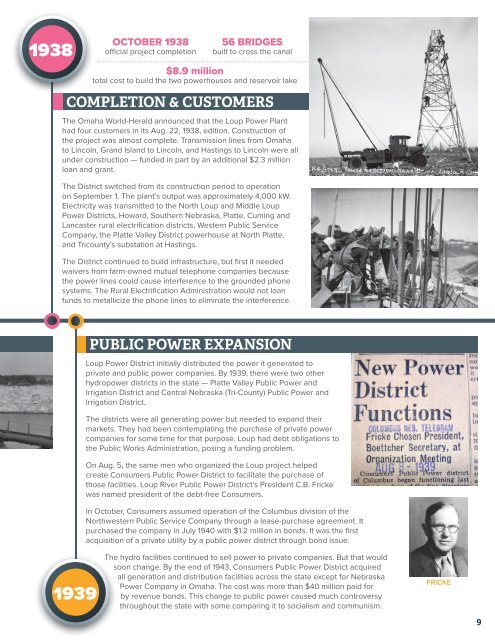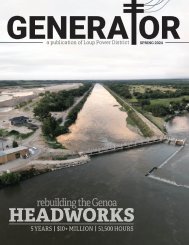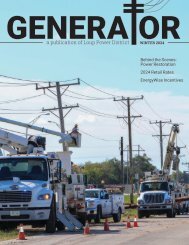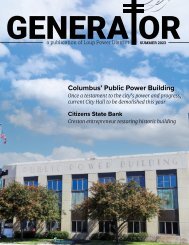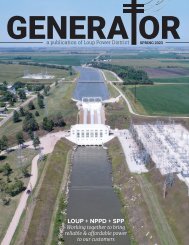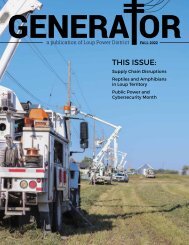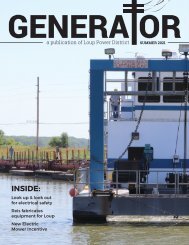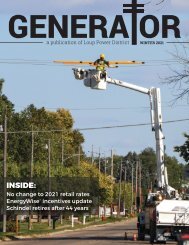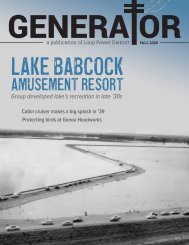Fall 2018 Generator
Loup celebrates 85 years of history this year. Learn more about the first public power district in Nebraska and how it shaped public power throughout the state and nation.
Loup celebrates 85 years of history this year. Learn more about the first public power district in Nebraska and how it shaped public power throughout the state and nation.
You also want an ePaper? Increase the reach of your titles
YUMPU automatically turns print PDFs into web optimized ePapers that Google loves.
1938<br />
OCTOBER 1938<br />
official project completion<br />
$8.9 million<br />
56 BRIDGES<br />
built to cross the canal<br />
total cost to build the two powerhouses and reservoir lake<br />
COMPLETION & CUSTOMERS<br />
The Omaha World-Herald announced that the Loup Power Plant<br />
had four customers in its Aug. 22, 1938, edition. Construction of<br />
the project was almost complete. Transmission lines from Omaha<br />
to Lincoln, Grand Island to Lincoln, and Hastings to Lincoln were all<br />
under construction — funded in part by an additional $2.3 million<br />
loan and grant.<br />
The District switched from its construction period to operation<br />
on September 1. The plant’s output was approximately 4,000 kW.<br />
Electricity was transmitted to the North Loup and Middle Loup<br />
Power Districts, Howard, Southern Nebraska, Platte, Cuming and<br />
Lancaster rural electrification districts, Western Public Service<br />
Company, the Platte Valley District powerhouse at North Platte,<br />
and Tricounty’s substation at Hastings.<br />
The District continued to build infrastructure, but first it needed<br />
waivers from farm-owned mutual telephone companies because<br />
the power lines could cause interference to the grounded phone<br />
systems. The Rural Electrification Administration would not loan<br />
funds to metallicize the phone lines to eliminate the interference.<br />
PUBLIC POWER EXPANSION<br />
Loup Power District initially distributed the power it generated to<br />
private and public power companies. By 1939, there were two other<br />
hydropower districts in the state — Platte Valley Public Power and<br />
Irrigation District and Central Nebraska (Tri-County) Public Power and<br />
Irrigation District.<br />
The districts were all generating power but needed to expand their<br />
markets. They had been contemplating the purchase of private power<br />
companies for some time for that purpose. Loup had debt obligations to<br />
the Public Works Administration, posing a funding problem.<br />
On Aug. 5, the same men who organized the Loup project helped<br />
create Consumers Public Power District to facilitate the purchase of<br />
those facilities. Loup River Public Power District’s President C.B. Fricke<br />
was named president of the debt-free Consumers.<br />
In October, Consumers assumed operation of the Columbus division of the<br />
Northwestern Public Service Company through a lease-purchase agreement. It<br />
purchased the company in July 1940 with $1.2 million in bonds. It was the first<br />
acquisition of a private utility by a public power district through bond issue.<br />
1939<br />
The hydro facilities continued to sell power to private companies. But that would<br />
soon change. By the end of 1943, Consumers Public Power District acquired<br />
all generation and distribution facilities across the state except for Nebraska<br />
Power Company in Omaha. The cost was more than $40 million paid for<br />
by revenue bonds. This change to public power caused much controversy<br />
throughout the state with some comparing it to socialism and communism.<br />
FRICKE<br />
9


